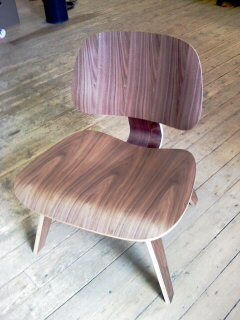Modern furniture
== Modern Furniture ==
Modern furniture refers to furniture produced from the late 19th century through the present that is influenced by modernism. Post-World War II ideals of cutting excess, commodification, and practicality of materials in design heavily influenced the aesthetic of the furniture. It is characterized by clean lines, minimalism, and the use of new materials such as steel, glass, and plastics.
History[edit | edit source]
The roots of modern furniture design can be traced back to the late 19th century and the Arts and Crafts movement, which emphasized craftsmanship and simplicity. The Bauhaus school, founded in 1919 in Germany, played a significant role in the development of modern furniture. The Bauhaus philosophy was to create functional, affordable, and aesthetically pleasing furniture.
Characteristics[edit | edit source]
Modern furniture is known for its:
- **Minimalist design**: Emphasis on simplicity and functionality.
- **Use of new materials**: Incorporation of materials like steel, glass, and plastics.
- **Clean lines**: Straight lines and geometric shapes.
- **Functionality**: Designed to be practical and useful.
Notable Designers[edit | edit source]
Some of the most influential modern furniture designers include:
Types of Modern Furniture[edit | edit source]
- **Chairs**: Iconic designs include the Barcelona chair, the Eames Lounge Chair, and the Wassily Chair.
- **Tables**: Known for their sleek designs, such as the Noguchi Table.
- **Sofas**: Often feature clean lines and modular designs.
- **Storage units**: Emphasize functionality and simplicity.
Influence[edit | edit source]
Modern furniture has had a lasting impact on interior design and continues to influence contemporary furniture design. Its principles of simplicity, functionality, and the use of modern materials remain relevant today.
Related Pages[edit | edit source]
Search WikiMD
Ad.Tired of being Overweight? Try W8MD's physician weight loss program.
Semaglutide (Ozempic / Wegovy and Tirzepatide (Mounjaro / Zepbound) available.
Advertise on WikiMD
|
WikiMD's Wellness Encyclopedia |
| Let Food Be Thy Medicine Medicine Thy Food - Hippocrates |
Translate this page: - East Asian
中文,
日本,
한국어,
South Asian
हिन्दी,
தமிழ்,
తెలుగు,
Urdu,
ಕನ್ನಡ,
Southeast Asian
Indonesian,
Vietnamese,
Thai,
မြန်မာဘာသာ,
বাংলা
European
español,
Deutsch,
français,
Greek,
português do Brasil,
polski,
română,
русский,
Nederlands,
norsk,
svenska,
suomi,
Italian
Middle Eastern & African
عربى,
Turkish,
Persian,
Hebrew,
Afrikaans,
isiZulu,
Kiswahili,
Other
Bulgarian,
Hungarian,
Czech,
Swedish,
മലയാളം,
मराठी,
ਪੰਜਾਬੀ,
ગુજરાતી,
Portuguese,
Ukrainian
Medical Disclaimer: WikiMD is not a substitute for professional medical advice. The information on WikiMD is provided as an information resource only, may be incorrect, outdated or misleading, and is not to be used or relied on for any diagnostic or treatment purposes. Please consult your health care provider before making any healthcare decisions or for guidance about a specific medical condition. WikiMD expressly disclaims responsibility, and shall have no liability, for any damages, loss, injury, or liability whatsoever suffered as a result of your reliance on the information contained in this site. By visiting this site you agree to the foregoing terms and conditions, which may from time to time be changed or supplemented by WikiMD. If you do not agree to the foregoing terms and conditions, you should not enter or use this site. See full disclaimer.
Credits:Most images are courtesy of Wikimedia commons, and templates Wikipedia, licensed under CC BY SA or similar.
Contributors: Prab R. Tumpati, MD




